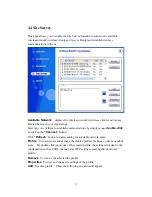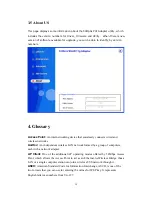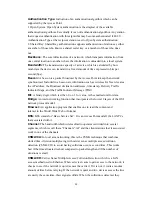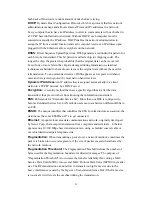
21
both back off and wait a random amount of time before retrying.
DHCP:
Dynamic Host Configuration Protocol, which is a protocol that lets network
administrators manage and allocate Internet Protocol (IP) addresses in a network.
Every computer has to have an IP address in order to communicate with each other in
a TCP/IP based infrastructure network. Without DHCP, each computer must be
entered in manually the IP address. DHCP enables the network administrators to
assign the IP from a central location and each computer receives an IP address upon
plugged with the Ethernet cable everywhere on the network.
DSSS:
Direct Sequence Spread Spectrum. DSSS generates a redundant bit pattern for
each bit to be transmitted. This bit pattern is called a chip (or chipping code). The
longer the chip, the greater the probability that the original data can be recovered.
Even if one or more bits in the chip are damaged during transmission, statistical
techniques embedded in the radio can recover the original data without the need for
retransmission. To an unintended receiver, DSSS appears as low power wideband
noise and is rejected (ignored) by most narrowband receivers.
Dynamic IP Address:
An IP address that is assigned automatically to a client
station in a TCP/IP network by a DHCP server.
Encryption:
A security method that uses a specific algorithm to alter the data
transmitted, thus prevent others from knowing the information transmitted.
ESS:
ESS stands for “Extended Service Set”. More than one BSS is configured to
become Extended Service Set. LAN mobile users can roam between different BSSs in
an ESS.
ESSID:
The unique identifier that identifies the ESS. In infrastructure association, the
stations use the same ESSID as AP’s to get connected.
Ethernet:
A popular local area data communications network, originally developed
by Xerox Corp., that accepts transmission from computers and terminals. Ethernet
operates on a 10/100 Mbps base transmission rate, using a shielded coaxial cable or
over shielded twisted pair telephone wire.
Fragmentation:
When transmitting a packet over a network medium, sometimes the
packet is broken into several segments, if the size of packet exceeds that allowed by
the network medium.
Fragmentation Threshold:
The Fragmentation Threshold defines the number of
bytes used for the fragmentation boundary for directed messages. The purpose of
"Fragmentation Threshold" is to increase the transfer reliability thru cutting a MAC
Service Data Unit (MSDU) into several MAC Protocol Data Units (MPDU) in smaller
size. The RF transmission can not allow to transmit too big frame size due to the
heavy interference caused by the big size of transmission frame. But if the frame size
is too small, it will create the overhead during the transmission.



































